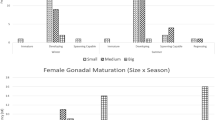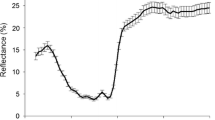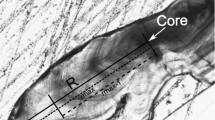Abstract
Gonadal sex steroid hormones are the principal factors that directly control the gonadal and morphological alterations during sex change in hermaphrodite fish; however, the physiological mechanism of action by which these hormones govern body coloration is poorly understood. The protogynous wrasse Pseudolabrus sieboldi is a good model for understanding the physiological mechanisms of gonadal and body color change during sex change in hermaphrodite fish. To obtain information on the relationship between sex steroids and body color change during the process of gonadal sex change, we analyzed body color, gonadal histology, and serum levels of sex steroids. Body color was analyzed using a quantitative analytical method based on the hue value. Compared to other body parts of the fish, the anal fin changed color the most, becoming increasingly redder in association with gonadal changes that converted ovaries to testes. Levels of serum 11-ketotestosterone (11KT) increased as the gonadal sex change proceeded, whereas no significant change was observed in estradiol-17β (E2) levels. Moreover, we found a significant correlation between the hue value of the anal fin and serum 11KT levels, but not E2 levels. These results suggest that androgen, but not estrogen, plays a principle role in the changes in both gonadal morphology and body color in the transformation from female to male in this species. To our knowledge, this is the first quantitative demonstration of the relationship between body color and serum steroid levels during sex change in fish.






Similar content being viewed by others
References
Amar MA, Miura T, Miura C, Yamauchi K (2001) Involvement of sex steroid hormones in the early stages of spermatogenesis in Japanese huchen (Hucho perryi). Biol Reprod 65:1057–1066
Arenas MI, Royuela M, Lobo MV, Alfaro JM, Fraile B, Paniagua R (2001) Androgen receptor (AR), estrogen receptor-α (ER-α) and estrogen receptor-β (ER-β) expression in the testis of the newt, Triturus marmoratus marmoratus during the annual cycle. J Anat 199:465–472
Atz JW (1964) Intresexuality in fishes. In: Armstrong CN, Marshall AJ (eds) Intersexuality in vertebrates including man. Academic, London, pp 145–232
Bhandari RK, Higa M, Nakamura S, Nakamura M (2004) Aromatase inhibitor induces complete sex change in the protogynous honeycomb grouper (Epinephelus merra). Mol Reprod Dev 67:303–307
Bhandari RK, Alam MA, Soyano K, Nakamura M (2006) Induction of female-to-male sex change in the honeycomb grouper (Epinephelus merra) by 11-ketotestosterone treatments. Zool Sci 23:65–69
Borg B (1994) Androgen in teleost fishes. Comp Biochem Physiol C 109:219–245
Brantley RK, Wingfield JC, Bass AH (1993) Sex steroid levels in Porichthys notaus, a fish with alternative reproductive tactics, and a review of the hormonal bases for male dimorphism among teleost fishes. Horm Behav 27:332–347
Cardwell JR, Liley NR (1991) Hormonal control of sex and color change in the stoplight parrotfish, Sparisoma viride. Gen Comp Endocrinol 81:7–20
Devlin RH, Nagahama Y (2002) Sex determination and sex differentiation in fish: an overview of genetic, physiological, and environmental influences. Aquaculture 208:191–364
Emerson SB, Carroll L, Hess DL (1997) Hormonal induction of thumb pads and the evolution of secondary sexual characteristics of the Southeast Asian fanged frog, Rana blythii. J Exp Zool 279:587–596
Eens M, Van Duyse E, Berghman L, Pinxten R (2000) Shield characteristics are testosterone-dependent in both male and female moorhens. Horm Behav 37:126–134
Fujii R (2000) The regulation of motile activity in fish chromatophores. Pigment Cell Res 13:300–319
Godwin JR, Thomas P (1993) Sex change and steroid profiles in the protandrous anemonefish Amphiprion melanopus (Pomacentridae, Teleostei). Gen Comp Endocrinol 91:144–157
Godwin J, Crews D, Warner RR (1996) Behavioral sex change in the absence of gonads in a coral reef fish. Proc R Soc Lond B 263:1683–1688
Grober MS, Sunobe T (1996) Serial adult sex change involves rapid and reversible changes in forebrain neurochemistry. Neuroreport 7:2945–2949
Grober MS, Jackson IMD, Bass AH (1991) Gonadal-steroids affect LHRH preoptic cell number in a sex-role changing fish. J Neurobiol 22:734–741
Guiguen Y, Jalabert B, Thouard E, Fostier A (1993) Changes in plasma and gonadal steroid hormones in relation to the reproductive cycle and the sex inversion process in the protandrous seabass, Lates calcarifer. Gen Comp Endocrinol 92:327–338
Hassin S, de Monbrison D, Hanin Y, Elizur A, Zohar Y, Popper DM (1997) Domestication of the white grouper, Epinephelus aeneus: 1. Growth and reproduction. Aquaculture 156:305–316
Hews DK, Moore MC (1995) Influence of androgens on differentiation of secondary sex characteristics in tree lizards, Urosaurus ornatus. Gen Comp Endocrinol 97:86–102
Higa M, Ogasawara K, Sakaguchi A, Nagahama Y, Nakamura M (2003) Role of steriod hormones in sex change of protogynous wrasse. Fish Physiol Biochem 28:149–150
Koulish S, Kramer CR (1989) Human chorionic gonadotropin (hCG) induces gonad reversal in a protogynous fish, the bluehead wrasse, Thalassoma bifasciatum (Teleostei Labridae). J Exp Zool 252:156–168
Kramer CR, Caddell MT, Bubenheimer-Livolsi L (1993) sGnRH-A ((d-Arg6, Pro9, NEt-) LHRH) in combination with domperidone induces gonad reversal in a protogynous fish, the bluehead wrasse, Thalassoma bifasciatum. J Fish Biol 42:185–195
Kroon FJ, Liley NR (2000) The role of steroid hormones in protogynous sex change in the Blackeye goby, Coryphopterus nicholsii (Teleostei: Gobiidae). Gen Comp Endocrinol 118:273–283
Kroon FJ, Munday PL, Pankhurst NW (2003) Steroid hormone levels and bi-directional sex change in Gobiodon histrio. J Fish Biol 62:153–167
Kroon FJ, Munday PL, Westcott DA, Hobbs JP, Liley NR (2005) Aromatase pathway mediates sex change in each direction. Proc Biol Sci 272:1399–1405
Kuwamura T, Nakashima Y (1998) New aspects of sex change among reef fishes: recent studies in Japan. Environ Biol Fish 52:125–135
Kuwamura T, Karino K, Nakashima Y (2000) Male morphological characteristics and mating success in a protogynous coral reef fish, Halichoeres melanurus. J Ethol 18:17–23
Larson ET, Norris DO, Summers CH (2003) Monoaminergic changes associated with socially induced sex reversal in the saddleback wrasse. Neuroscience 119:251–263
Lee YH, Du JL, Yueh WS, Lin BY, Huang JD, Lee CY, Lee MF, Lau EL, Lee FY, Lee MF, Lau EL, Lee FY, Morry C, Nagahama Y, Chang CF (2001) Sex change in the protandrous back porgy, Acanthopagrus schlegeli: a review in gonadal development, estradiol, estrogen receptor, aromatase activity and gonadotropin. J Exp Zool 290:715–726
Lee YH, Yueh WS, Du JL, Sun LT, Chang CF (2002) Aromatase inhibitors block natural sex change and induce male function in the protandrous black porgy, Acanthopagrus schlegeli Bleeker: possible mechanism of natural sex change. Biol Reprod 66:1749–1754
Liu X, Liang B, Zhang S (2004) Sequence and expression of cytochrome P450 aromatase and FTZ-F1 genes in the protandrous black porgy (Acanthopagrus schlegeli). Gen Comp Endocrinol 138:247–254
Matsuyama M, Morita S, Hamaji N, Kashiwagi M, Ohta K, Nagahama Y (1997) Diurnal spermatogenesis and spawning in the secondary male of a protogynous wrasse, Pseudolabrus japonicus (Teleostei, Labridae). Zool Sci 14:1001–1008
Matsuyama M, Morita S, Nasu T, Kashiwagi M (1998) Daily spawning and development of sensitivity to gonadotropin and maturation-inducing steroid in the oocytes of the bambooleaf wrasse Pseudolabrus japonicus. Environ Biol Fish 52:281–290
Miura T, Miura C, Ohta T, Nader MR, Todo T, Yamauchi K (1999) Estradiol-17β stimulates the renewal of spermatogonial stem cells in males. Biochem Biophys Res Commun 264:230–234
Morita S, Matsuyama M, Kashiwagi M (1997) Seasonal changes of gonadal histology and serum steroid hormone levels in the bambooleaf wrasse Pseudolabrus japonicus. Bull Jpn Soc Sci Fish/Nippon Suisan Gakkai Shi 63:694–700
Nakamura M, Hourigan TF, Yamauchi K, Nagahama Y, Grau EF (1989) Histological and ultrastructural evidence for the role of gonadal steroid hormones in sex change in the protogynous wrasse Thalassoma duperrey. Environ Biol Fishes 24:117–136
Nakazono A (1979) Studies on the sexual reversal and spawning behavior of the five species of Japanese labrid fishes. Rep Fish Res Lab Kyushu Univ 4:1–64
Ogino Y, Katoh H, Yamada G (2004) Androgen dependent development of a modified anal fin, gonopodium, as a model to understand the mechanism of secondary sexual character expression in vertebrats. FEBS Lett 575:119–126
Ohta K, Matsuyama M (2002) Steroidogenic pathways to 17,20β-dihydroxy-4-pregnen-3-one and 17,20β,21-trihydroxy-4-pregnen-3-one in the ovarian follicles of the bambooleaf wrasse, Pseudolabrus sieboldi. Fish Sci 68:41–50
Ohta K, Mine Y, Yamaguchi A, Matsuyama M (2001) Steroidogenic pathway to estradiol-17β synthesis in the ovarian follicles of the protogynous wrasse, Pseudolabrus sieboldi. Zool Sci 18:937–945
Ohta K, Sundaray JK, Okida T, Sakai M, Kitano T, Yamaguchi A, Takeda T, Matsuyama M (2003) Bi-directional sex change and its steroidogenesis in the wrasse Pseudolabrus sieboldi. Fish Physiol Biochem 28:173–174
Reinboth R (1970) Intersexuality in fishes. Mem Soc Endocrinol 18:515–543
Roberts DE, Schlieder Jr RA (1983) Induced sex inversion, maturation, spawning and embryogeny of the protogynous grouper, Mycteroperca microlepis. J World Maricult Soc 14:639–649
Sakai Y, Karino K, Nakashima Y, Kuwamura T (2002) Status-dependent behavioral sex change in a polygynous coral-reef fish, Halichoeres melanurus. J Ethol 20:101–105
Shapiro DY (1979) Social behavior, group structure, and the control of sex reversal in hermaphroditic fish. Adv Study Behav 10:43–102
Shapiro DY (1987) Sexual differentiation, social behavior and the evolution of sex change in coral reef fishes. Bioscience 37:490–497
Sinisi AA, Pasquali D, Notaro A, Bellastella A (2003) Sexual differentiation. J Endocrinol Invest 26(3 Suppul):23–28
Sugimoto M (2002) Morophological color changes in fish: regulation of pigment cell density and morphology. Microsc Res Tech 58:496–503
Sundaray JK, Ohta K, Yamaguchi A, Suzuki K, Matsuyama M (2003) Diurnal rhythm of steroid biosynthesis in the testis of terminal phase male of protogynous wrasse (Pseudolabrus sieboldi), a daily spawner. Fish Physiol Biochem 28:193–195
Sunobe T, Nakamura M, Kobayashi Y, Kobayashi T, Nagahama Y (2005) Aromatase immunoreactivity and the role of enzymes in steroid pathways for inducing sex change in the hermaphrodite gobiid fish Trimma okinawae. Comp Biochem Physiol A Mol Integr Physiol 141:54–59
Tan-Fermin JD, Garcia LMB, Castillo Jr AR (1994) Induction of sex inversion in juvenile grouper, Epinephelus suillus, (Valenciennes) by injections of 17 alpha-methyltestosterone. Jpn J Ichthyol 40:413–420
Tang F, Chan STH, Lofts B (1974) Effect of steroid hormones on the process of natural sex reversal in the rice-field eel, Monopterus albus (Zuiew). J Comp Endocrinol 24:227–241
Warner RR, Schultz ET (1992) Sexual selection and male characteristics in the bluehead wrasse, Thalassoma bifasciatum: mating site acquisition, mating site defense, and female choice. Evolution 46:1421–1442
Yeh S, Tsai M-Y, Xu Q et al (2002) Generation and chracterization of androgen receptor knockout (ARKO) mice: An in vivo model for the study of androgen functions in selective tissues. Proc Natl Acad Sci USA 99:13498–13503
Yeung WSB, Chan STH (1987a) The plasma sex steroid profiles in the freshwater, sex reversing teleost fish, Monopterus albus (Zuiew). Gen Comp Endocrinol 65:233–242
Yeung WSB, Chan STH (1987b) A radioimmunoassay study of the plasma levels of sex steroids in the protandrous, sex-reversing fish Rhabdosargus sarba (Sparidae). Gen Comp Endocrinol 66:353–363
Acknowledgments
We extend our sincere thanks to Captain Y. Shichida of the research vessel Wakasugi for providing generous support during fish sampling, and to the staff of the Fishery Research Laboratory of Kyushu University for assistance during the experiments. This study was supported by JSPS Research Fellowship for Young Scientists.
Author information
Authors and Affiliations
Corresponding author
Additional information
Communicated by S. Nishida.
Rights and permissions
About this article
Cite this article
Ohta, K., Hirano, M., Mine, T. et al. Body color change and serum steroid hormone levels throughout the process of sex change in the adult wrasse, Pseudolabrus sieboldi . Mar Biol 153, 843–852 (2008). https://doi.org/10.1007/s00227-007-0856-0
Received:
Accepted:
Published:
Issue Date:
DOI: https://doi.org/10.1007/s00227-007-0856-0




